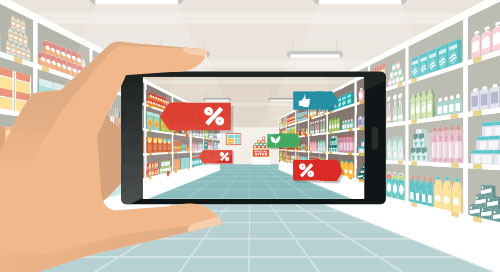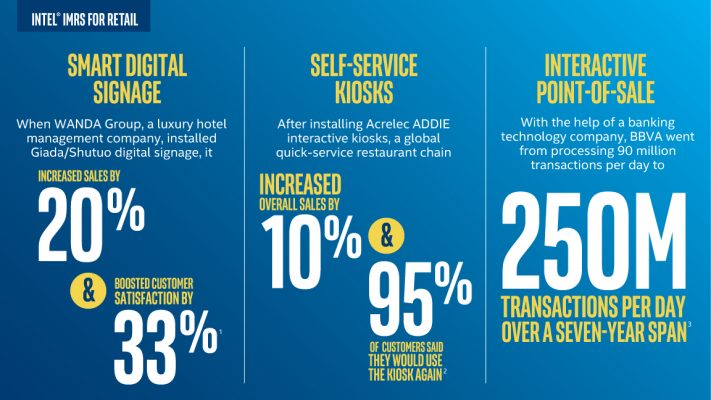Why Retailers Should Embrace Digital Transformation

Even as online shopping continues to grow, physical stores remain a powerful way to connect with customers. “Humans are still the most important and effective component in the customer experience,” said Jane Liston, Retail Strategy Lead at CDW, an IT solutions and services provider for multinational businesses.
Now, through digital transformation, retailers are bringing together the personalization of brick-and-mortar stores and the convenience of online shopping. The result? A whole new level of customer experience—and increased spending and brand loyalty from happy shoppers.
While it might seem that digitalization would dehumanize shopping, digital tools can actually help staff create a more personalized experience. “Technology can be used to reduce the time staff spend away from customers,” noted Liston.
And that’s just the start. Digital transformation can drive footfall into stores, increase basket size, improve the availability and visibility of stock, and more (Figure 1). Digitization can help retailers monitor utility expenditures and ultimately reduce operating costs. Artificial Intelligence can offer a translation tool for international customers. And innovative technology can even use data from heatmapping to place underselling stock in busier areas of a store.

Roadblocks on the Path to Innovation
With all these benefits, why aren’t more retail stores moving toward digital transformation?
Some stores are wary of digital transformation because they’re worried about possible disruption to their business. “Many in-house systems have been in place for 10 or more years, and have challenges providing critical services without having to support new technologies,” said Liston.
This is understandable: Imagine spending a good portion of your budget to implement all this new tech, and discovering that your payment system is no longer working. It’s enough to make any retailer hesitate at the cusp of digital transformation.
Then there’s the confusion factor: So many vendors are out there vying for retailers’ digital dollars, it’s difficult to know which ones best address their needs. Where do they start, how do they make the right choice—and how do they even find the time to do all this?
Add to that the complexity of so many systems and services that depend on one another, and retailers have a good excuse to stall on the path to digitizing their business.
Overcoming the Challenges to Digital Transformation
Luckily, said Liston, retailers just beginning on this journey can take steps to make their digital transformation a success.
First, it’s critical for retailers to prioritize their goals, whether they’re to reduce operational costs, drive footfall in their brick-and-mortar stores, increase cart size, or build brand awareness. “It shouldn’t be seen as ‘We gained a technology’ so much as ‘We achieved this goal through this technology,’” said Liston.
Next, retailers should consider investing in IT infrastructure even if they’re not sure what their digital transformation will look like down the road. More and more customers are expecting a seamless omnichannel experience, so chances are retailers will eventually all need to go in this direction—and the longer they wait to get started, the harder it will be.
Third, retailers need to tackle the confusion conundrum we talked about earlier. Liston recommends that retailers keep an open mind while exploring the options—in other words, listen to vendors and understand that the solution may not look at all like what they were envisioning. Then they can split up the project into “baby steps” phases. Taking on new technology is a big, confusing deal, and these tactics help break it down into manageable pieces.
Finally, Liston recommended that retailers establish an agile way of running the proof of concept to quickly identify the best solutions. Once again, new tech requires new ways of thinking.
The Future of Retail Innovation
For retailers who are new to digital transformation, the good news is that the process is likely to become easier and less expensive over time. “As digitization moves from cutting edge to standard, it will reduce costs,” said Liston. “The underlying backbone and processes to support this change are becoming cheaper, more available, and more proven.”
For example, as suppliers productize some of these technologies, less development time will be required—reducing the time and money investment for retailers. When products like “RFID Inventory” become off-the-shelf, retailers will need only to purchase and implement.
Also, with 5G on the horizon, wireless solutions can be deployed with greater mobility and support greater bandwidth requirements. Said Liston, “This aids in the fluidity of a store, and bolsters the ability to be creative when designing technologies to install in the retail environment.”
While many retailers feel pinched by competition from online shops, technology is on their side. Taking steps now toward digital transformation will help them overcome challenges—and thrive.